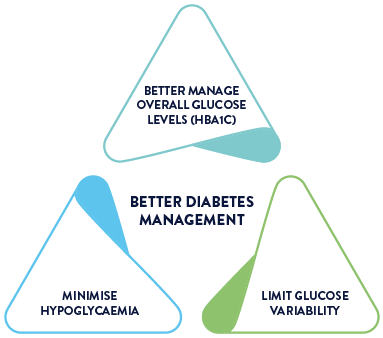The Triangle of Diabetes Care is an emerging treatment strategy that is centred around three diabetes management targets, reaching all three can help improve outcomes for patients with Type 1 and Type 2 diabetes. When used with the FreeStyle Libre system you can help your patients hit targets in all three areas using the glucose data from their sensor to inform your treatment plan.
Triangle of Diabetes Care
The 3 key areas for improving diabetes management
What is the Triangle of Diabetes Care?
The Triangle of Diabetes Care acknowledges that improving your patients' HbA1c is important, but it also emphasises a need to minimise hypoglycaemia and limit glucose variability.
Ideally all three targets should be achieved but might not always be possible. Sensor-based glucose monitoring with the FreeStyle Libre portfolio can support you and your patients in achieving these goals.
The three goals of the Triangle of Diabetes Care for better diabetes management are: better manage overall glucose levels (HbA1c), minimise hypoglycaemia, limit glucose variability.
The Triangle of Diabetes Care was developed by Professor Ramzi Ajjan, Professor of Metabolic Medicine and Consultant in Diabetes and Endocrinology at Leeds University and Leeds Teaching Hospitals Trust.

HbA1c is an accepted measure of overall glucose control over the past three months and illustrates how a person with diabetes has been managing their treatment regime.
More regular glucose monitoring with the FreeStyle Libre system can help your patients achieve better long-term diabetes management.
Real-world analysis of data collected from over 470,000 FreeStyle Libre readers show that the estimated HbA1c reduced as scan rate increased1. As scan rate increased from lowest to highest scan groups (3.6 and 39.5 scans/day) the estimated HbA1c decreased from 8.2% to 6.7% (1200 to 900 mg/dL).
Find out more about improving overall glucose levels, how greater diabetes control is associated with better long-term outcomes and the limitations of HbA1c in our Healthcare Professional Education module about the Triangle of Diabetes Care.

Hypoglycaemia is a common issue for those living with both Type 1 and Type 2 diabetes, although it’s more frequent in people who have been living with diabetes for longer and those using insulin.
Episodes of hypoglycaemia are unpredictable and can complicate your patients’ individual goals towards better glucose management. Hypoglycaemia also impacts their well-being and social functioning.2
The FreeStyle Libre systems are proven to help users reduce hypoglycaemia
The FreeStyle Libre systems all display trend arrows to show your patients where their glucose levels are heading. This means that even in the absence of hypoglycaemic symptoms, your patient can know if their glucose levels are falling and take the appropriate action. Current Time in Range consensus suggests less than <70mg/dL & less than 4% including 1% <54mg/dL of time should be spent below those ranges for adults with type 1 and type 2 diabetes who are not pregnant, not older, or at risk.7
In separate clinical trials for those with Type 1 and Type 2 diabetes, compared to SMBG testing, FreeStyle Libre system users significantly reduced the amount of time that their glucose dipped into the hypoglycaemic zone (<70mg/dL) by 38% and 43% respectively3,4.
Find out more about minimising hypoglycaemia in our Healthcare Professional Education modules about the Triangle of Diabetes Care and Targeting Hypoglycaemia.

Limit glucose variability
Even if your patient’s HbA1c is on target, they may have been experiencing daily swings between high and low glucose levels or significant day-to-day glucose variability.
Avoiding glucose excursions and minimising the size of these daily swings are important for improving your patient’s overall health and management of their diabetes.5 In fact, the DCCT study showed that changes in a patient’s mean daily glucose as well as pre- and post-prandial hyperglycaemia were a better predictor of cardiovascular disease than HbA1c.6
Find out more about limiting glucose variability in our Healthcare Professional Education modules about the Triangle of Diabetes Care and Targeting Glucose Variability.

FreeStyle Libre Portfolio & The Triangle of Diabetes Care
The FreeStyle Libre portfolio empowers patients to hit targets on each of the three sides of the Triangle of Diabetes Care and improve their overall glucose control. Even if one goal cannot be reached, an improvement of one or both of the other goals will have a positive effect on the overall health of your patients.
Additional Resources
Real-World Data
Find out more about living with diabetes and how the FreeStyle Libre portfolio can help patients better manage their diabetes using data from real users.
References & Disclaimers
1. Lang, et al. Expanded Real-world Use Confirms Strong Association between Frequency of Flash Glucose Monitoring and Glucose Control. Advanced Technologies & Treatments for Diabetes Meeting. Berlin. February 20-23, 2019. Diabetes Technology & Therapeutics, Volume 21, Supplement 1, 2019.
2. UK Hypoglycaemia Study Group. Risk of hypoglycaemia in types 1 and 2 diabetes: effects of treatment modalities and their duration. Diabetologia 50, 1140–1147 (2007). https://doi.org/10.1007/s00125-007-0599-y
3. Bolinder J et al Lancet 2016; 388: 2254–2263.
4. Haak T et al Diabetes Ther 2017; 8: 55–73.
5. Ceriello A. et al, Lancet Diabetes Endocrinol 2019 : http://dx.doi.org/10.1016/S2213-8587(18)30136-0
6. Kilpatrick, E.S., Rigby, A.S. & Atkin, S.L. Mean blood glucose compared with HbA1c in the prediction of cardiovascular disease in patients with type 1 diabetes. Diabetologia 51, 365–371 (2008). https://doi.org/10.1007/s00125-007-0883-x
7. Battelino, T. Diabetes Care (2019): https://doi.org/10.2337/dci19-0028
